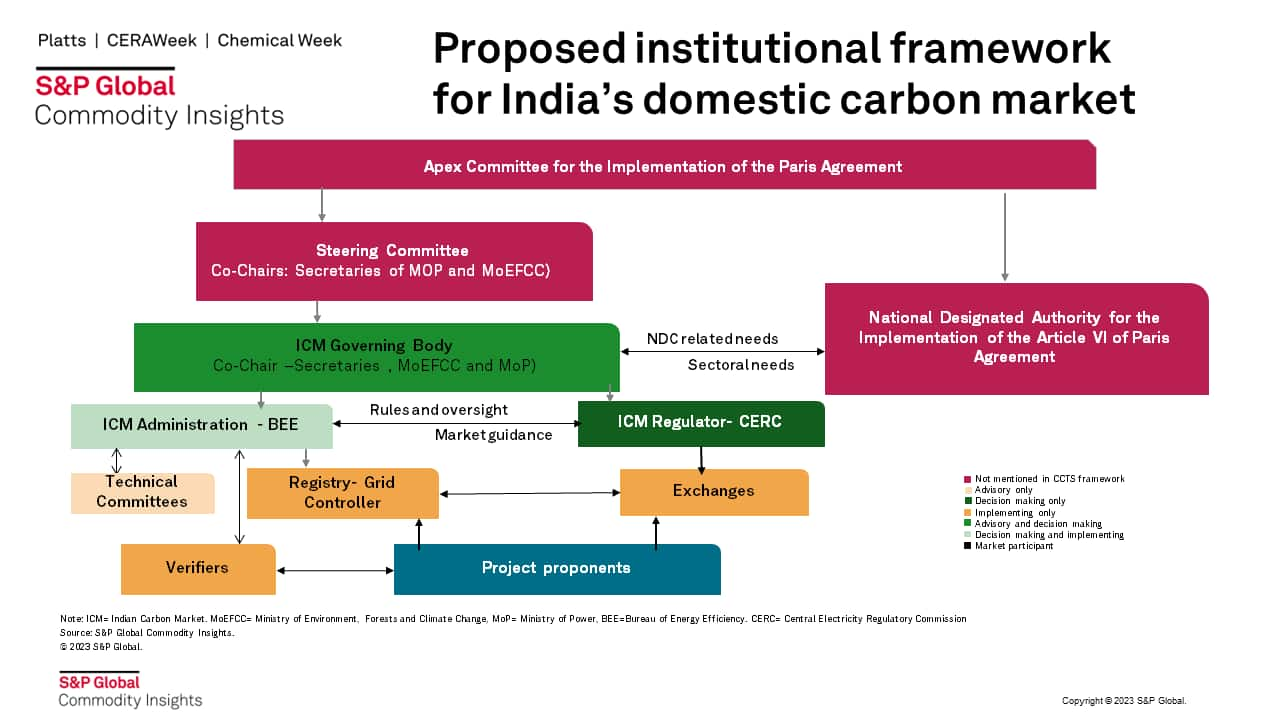S&P Global Offerings
Featured Topics
Featured Products
Events
S&P Global Offerings
Featured Topics
Featured Products
Events
S&P Global Offerings
Featured Topics
Featured Products
Events
Solutions
Capabilities
Delivery Platforms
News & Research
Our Methodology
Methodology & Participation
Reference Tools
Featured Events
S&P Global
S&P Global Offerings
S&P Global
Research & Insights
Solutions
Capabilities
Delivery Platforms
News & Research
Our Methodology
Methodology & Participation
Reference Tools
Featured Events
S&P Global
S&P Global Offerings
S&P Global
Research & Insights
S&P Global Offerings
Featured Topics
Featured Products
Events
Support
May 30, 2023
By Mohd. Sahil Ali
The Ministry of Power (MoP) released a draft on the Carbon Credit Trading Scheme (CCTS) on March 27, 2023, with the aim to establish a framework for the Indian carbon market (ICM). The ICM derives its legislative foundation from the Amendments to the 2001 Energy Conservation Act, adopted by the Indian legislature in December 2022. Prior to this, a more comprehensive draft carbon market policy document was formulated by the Bureau of Energy Efficiency (BEE) in October 2022. This aimed at define the scope design and other operational details of the proposed hybrid (compliance cum voluntary) carbon market[1].
The framework document goes a long way in clarifying the roles and relationships of various actors envisaged, such as the governing body, administrator, regulator, registry, verifiers, exchanges, and technical committees. It proposes to set up a governing body, named the ICM Governing Board (ICMGB) which will be co-chaired by secretaries of the Ministry of Environment, Forests and Climate Change (MoEFCC) and the Ministry of Power (MoP) and include members of several other key ministries that are linked to greenhouse gas (GHG) mitigation aiming to achieve India's nationally determined contributions (NDCs). The ICMGB will play a key role in giving direction to the ICM, framing norms, and providing oversight.
BEE will be the ICM administrator and will accredit carbon verifiers (ACVs) responsible for measuring, reporting and verification, and induct technical committees who will provide sectoral guidance on abatement potentials and costs. The registry function will be handled by the Grid Controller of India which will coordinate with market players and exchanges, receiving periodic guidance from the ICM administrator. The regulatory duties will be fulfilled by the Central Electricity Regulatory Commission (CERC), which will be responsible for balancing market power and protecting market integrity. It will also select and govern the carbon trading exchanges.

Our assessment of the framework document reveals certain areas where further enhancements, guidance, and transparency will strengthen the emerging domestic carbon market ecosystem:
Customers can read the full report here or log on to our Connect platform to view our full range of offerings on India's carbon market and related topics.
Past reports in this series include:
For more information on this research and its related service offering, please visit the Asia Pacific Regional Integrated Service(opens in a new tab) page.
Mohd. Sahil Ali is a senior sustainability analyst with the Gas, Power, and Climate Solutions group at S&P Global Commodity Insights and covers cross-cutting issues in power and renewables for South Asian markets.
Posted on 30 May 2023
_________________
[1] These entities are included in the BEE's carbon market policy framework document and represented by the red boxes in the above infographic.
[2] A compliance market is one in which emitting entities are mandated by the government to reduce emissions trade in carbon credits with other obligated entities. In a voluntary market, emitting entities trade in carbon credits on their own volition without any government obligations or mandates. A hybrid market includes both compliance and voluntary market elements, with rules of engagement between the two sets of players.
This article was published by S&P Global Commodity Insights and not by S&P Global Ratings, which is a separately managed division of S&P Global.
